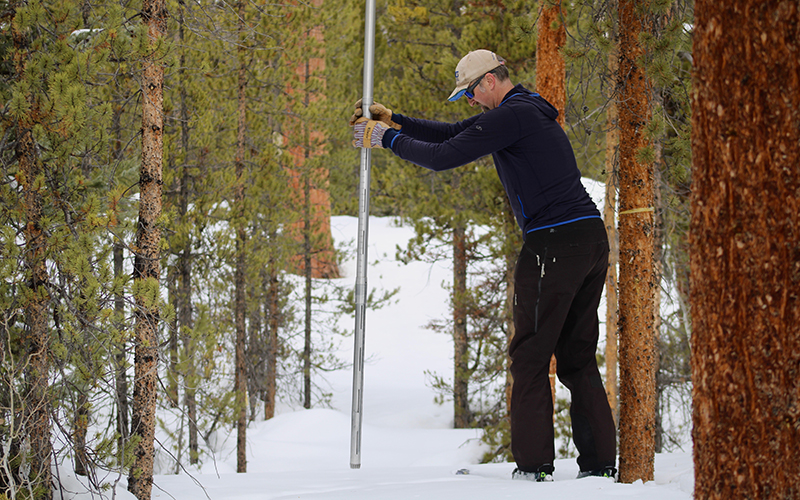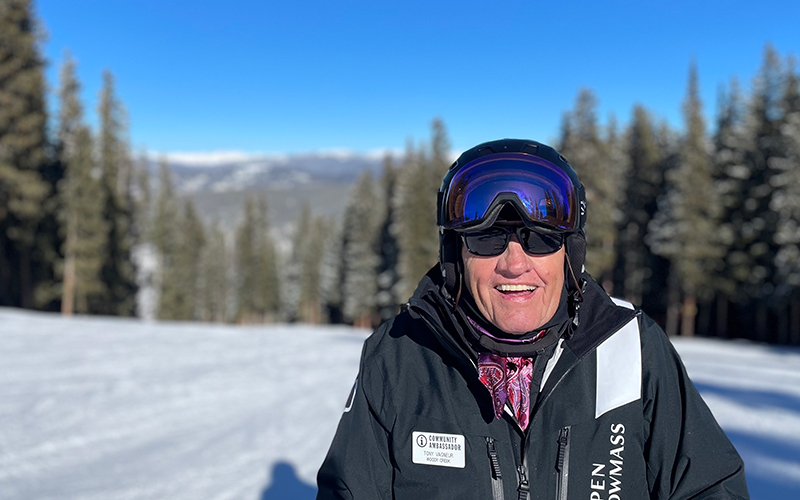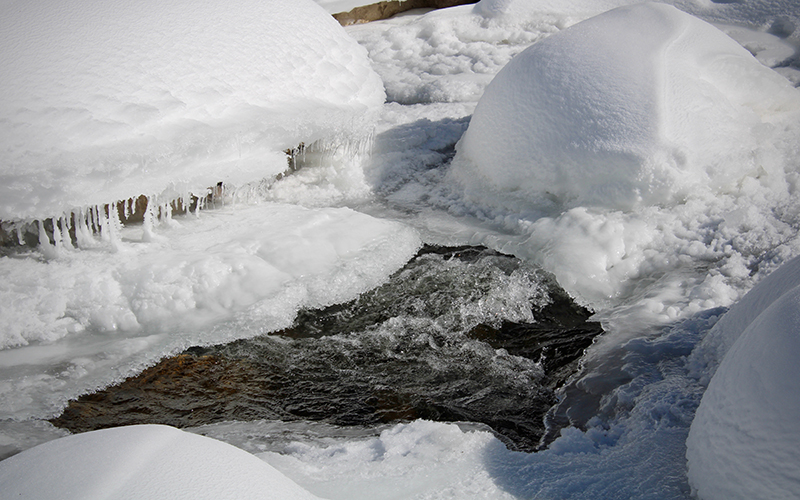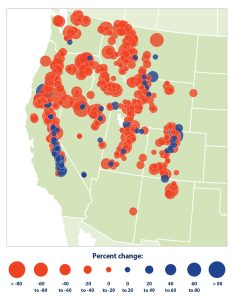
Stephen Jaouen measures snow outside Basalt, Colorado. High-mountain snowmelt is the largest source of water for the Colorado River, and climate change is gradually reducing the amount that falls. This year, a shifted baseline for what counts as “average” paints a somewhat deceptive picture of how much snow is stored high in the mountains. (Photo by Alex Hager/KUNC)

Tony Vagneur, a native of Aspen, Colorado, says changes in snow are hard to notice on the ski slopes. But he has noticed his hay fields are drier in March than they used to be. (Photo by Alex Hager/KUNC)

Ruedi Reservoir, just downstream of a snow survey site, holds water within the Roaring Fork watershed. That watershed makes up 0.5% of the landmass in the Colorado River basin, but provides about 10% of its water. (Photo by Alex Hager/KUNC)
ASPEN, Colo. – High in the Rocky Mountains of Colorado and Wyoming, under thin air and bluebird skies, the Colorado River Basin is slowly replenishing its savings account. Craggy peaks become smooth walls of white, and snow piles up against conifer trunks, covering even the deepest, darkest corners of the forest in a glimmering blanket.
Snow that accumulates on the western slope of the Rockies eventually becomes water in the Colorado River. Some of it will flow as far south as Mexico, running through kitchen faucets in cities and suburbs along the way, or watering crops that keep America fed.
But year by year, the snows are getting slightly smaller and melting earlier – slowly revealing the sting of a warming planet. The way we measure the snow is changing, too, as a shifting baseline for what counts as “average” paints a somewhat deceptive picture of how much snow is stored up in the mountains.
It’s the type of thing that plays out subtly over the course of a human lifetime. On ski mountains across the region, it might be hard to notice anything beyond the normal ebb and flow of good years and bad.
Tony Vagneur, who was born and raised in Aspen, Colorado, is looking out across the slopes of the town’s main ski mountain, basking in the warm afternoon sun and the glory of a classic Colorado ski day.
“Blue sky, bluebird day,” he said. “The kind everybody talks about. Temperatures probably in the low teens. The snow is hard and fast. I mean, it’s perfect.”
Aspen Mountain and the town at its base depend on snow to keep the resort running. Vagneur has been skiing it for more than 70 years, and hasn’t noticed much change as far as the snow is concerned. But down in the valley, where he lives on a ranch, signs of changing snowpack are manifesting, starting with a dry year in the mid-1970s that left his fields snowless by March.
“I hate to say, but many Marches after that, the hay fields have been bare,” he said. “So anecdotally, you could say it is probably a little less snow. Or maybe it’s warmer. I don’t know, not being a scientist. But it’s noticeable.”

Water rushes through the Fryingpan River, just downstream of a snow survey site. It’s part of the Roaring Fork watershed, which makes up 0.5% of the landmass in the Colorado River Basin but provides about 10% of its water. (Photo by Alex Hager/KUNC)
It’s noticeable to the scientists, too, who have data to back up observations that Colorado’s snowpack is changing.
“If you look at long-term climate trends, you see a general warming in climate, which doesn’t necessarily change the amount of precipitation in headwaters areas, but changes how it falls,” said Heather Lewin, science and policy director at the Roaring Fork Conservancy, a not-for-profit that seeks to promote and protect the critical Roaring Fork River.
The conservancy does river research and education just downstream of Aspen, where snowmelt rushes through the Roaring Fork Valley on its way to the Colorado. The Roaring Fork watershed is 0.5% of the landmass in the Colorado River Basin but provides about 10% of its water.
“We’re seeing more precipitation as rain rather than as snow,” Lewin said, “so that means instead of having a savings account, we have a spending account that hits the river and moves quickly, versus a savings account that kind of gives us a long-term security.”
As snow behavior changes, so does the way we understand snow measurement. In spring 2021, the National Oceanic and Atmospheric Administration shifted how it calculates averages for all its data.
In a way, it’s routine. Every 10 years, NOAA moves the three-decade window that it uses for averages. But the rapidly accelerating effects of climate change mean the current window sticks out from previous 30-year periods. The current window runs from 1991 to 2020, which includes the hottest-ever period in America’s recorded weather history.
Because of that, snowpack data tells a slightly deceptive story. It’s most frequently shared as a percent of average when it appears in newspapers and reports for skiers and river users. For example, if snowpack is at 120%, the number would appear far lower if current totals were compared to normals going back further than 30 years.

A map shows trends in April snowpack in the Western U.S. from 1955-2020. Blue circles represent increased snowpack, red circles represent a decrease. (Map by USDA Natural Resources Conservation Service)
“The context right now is that 120% of average might give us an inflated sense of confidence as to how much water we’re going to see this summer and how much snow we’re really looking at right now,” Lewin said.
Other scientists are noting some changes, too, including those who actually gather the snow data.
“When I first started 15 years ago, we’d actually measure some snow in the April-May survey,” said Stephen Jaouen, a conservationist with the Natural Resources Conservation Service. “And a lot of times now, we just walk in and there’s no snow.”
Jaouen conducts snow surveys deep in the Roaring Fork watershed, where getting good data requires a bit of trekking. After a drive downstream from Aspen, the winding mountain road extends past the fringes of cellphone signal, past a sprawling reservoir and up through dense thickets of aspens.
At a trailhead on the side of the road, Jaouen and a technician click into backcountry skis and begin the journey downhill – a stumbly start-and-stop bushwhack through low brush and scattered tree trunks.
Then, aided by traction skins on the bottoms of their skis, the pair hike even further into the woods, following the route from memory until they reach the snow survey site. Here, Jaouen assembles a long aluminum tube and pulls out an analog scale. At nine points, he plunges the tube into the snow underfoot, filling it with a core of the white stuff. Using a ruler on the tube and the handheld scale, Jaouen and the technician take measurements and jot down findings in a little notebook.
The process may sound a bit old-school, and that’s because it is. This site has been used for snow measurement – conducted in the same way – for almost a century. The only thing that’s changed, Jaouen said, is that heavy steel tubes were swapped for aluminum for easier carrying.
“You just know that the data has been collected the same way for so long that we can see rises and falls in snow water equivalent,” he said. “You know what different years were happening all the way back into the ’30s.”
In the 1970s and ’80s, the old-fashioned techniques were joined by a high-tech network of SNOTEL measuring sites, adding greater depth to the West’s understanding of snowpack. These sites use sensitive measuring equipment and automatically beam data to researchers via satellite.

Snow surveys in Colorado have looked largely the same for decades. On the left, Dayton Knutson and Stephen Jaouen carry out a snow survey in 2022. On the right, Jack Washichek and George Peak do the same on a snow survey in 1955. The Natural Resources Conservation Service has a reliable dataset going back nearly a century. (Photos by Alex Hager/KUNC and the USDA)
Together, the new and old data paint an increasingly important picture of the region’s water supply.
“I think as the West got developed and more and more people showed up and are using the river, it becomes that much more important that people understand it and know that this water one day is going to feed California avocados or Mexico cantaloupe,” Jaouen said.
Although drought has dominated headlines during many recent Colorado summers, Lewin and others say the fate of the Colorado River is determined in the winter. Such factors as soil moisture and temperature play an important role in water availability and the likelihood of wildfire, but snow is a key metric for understanding how dry summers will be.
As the two-decade drought pushes water issues more prominently into the public eye, she said it’s important that the public fully understands data about snow and rivers.
“You need to look at the context that you’re reading or listening to it in because often there’s a bigger picture,” Lewin said. “The data all tells a story, and it just depends on the context that we’re reading it in.”
-This story is part of ongoing coverage of water in the West, produced by KUNC in Colorado and supported by the Walton Family Foundation. KUNC is solely responsible for its editorial coverage.